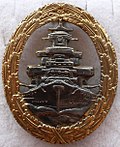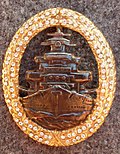Fleet war badge
The naval war badge was donated on April 30, 1941 by the Commander-in-Chief of the Navy , Grand Admiral Erich Raeder . It could be awarded to all crew members, including soldiers who fell or died in combat, battleships and cruisers used.
Appearance
The oval badge made of tombac bronze (later made of fine zinc) shows in the middle a stylized battleship approaching the viewer. The marine painter Adolf Bock said about his design : A badge for the heavy (sea) armed forces was required. So the badge had to look massive, warlike and massive. The massive representation was best achieved by showing the ship from the front with a mighty bow wave and threatening cannon barrels. The ship is surrounded by an oak wreath . The badge shows the sovereign badge of the Navy on its upper side, an imperial eagle with outstretched wings, which holds an upside down swastika in its claws .
| The naval war badge | ||||||
|---|---|---|---|---|---|---|
| Fleet war badge | Fleet War Badge (1957 version) | Fleet war badge with diamonds ( replica ) | Fleet war badge with diamonds (1957 version) | |||
Foundation decree
The foundation decree on the naval war badge was published in the Reichsgesetzblatt on April 30, 1941. Its full wording was:
- 1. In the struggle against England, the battlecruisers and cruisers on far-reaching, daring undertakings inflicted considerable losses on the enemy in shipping space and thus tightened the ring of blockades around England. In recognition of these deeds, I order the introduction of a war badge for the naval forces deployed (naval war badge).
- 2. The badge can be awarded to the crews (including fallen or deceased soldiers and other eligible candidates) of the battleships deployed. The award is made by the commander of the association.
- 3. The badge can also be awarded to crews of the other ships deployed with the naval forces, for which a special war badge has not yet been provided. The award is made by the superior commander in the service position of at least one rear admiral (commodore).
- 4. The badge is worn with the uniform like the U-boat war badge (1939) .
Award terms
The award conditions were published in the Marineverordnungsblatt dated June 5, 1941. These goods:
- I. General Conditions
- Worthiness and good leadership
- II. Special conditions
- a) Probation on one or more war journeys totaling at least 12 weeks
- b) The deadline set under a) can be deviated from:
- 1. if the company was particularly successful or the individual has particularly distinguished himself or himself here
- 2. if a ship is lost to enemy action and in special cases if it is wounded
- 3. for participating in both battles near Iceland ( Rawaldpindi ) and Jan Mayen
- III. The badge can only be awarded to deceased people who have fulfilled or nearly fulfilled the requirements if their death is the result of an injury, an accident or an illness which they suffered or were incurred during the patrol.
- IV. The naval war badge may only be awarded to crews of the other ships deployed with the naval forces if such ships were entrusted with combat tasks in connection with naval forces.
- V. The fleet command is authorized to supplement the conditions given above, if necessary in consultation with the commanding Admirals North and East.
Extended award terms
In the months and years that followed, the High Command of the Navy issued several supplementary award conditions in order to honor those marines who were not covered by the previous award conditions. These were (in extracts):
July 15, 1941
- 1. According to the implementation regulations, the badge is awarded to rescued crew members of the following ships: Battleship Bismarck , cruiser Admiral Graf Spee , cruiser Blücher
- 2. According to the implementation regulations, the following companies are to be regarded as particularly successful
- a) Operation of the cruiser Admiral Hipper in February 1941
- b) Operation of the battleships Gneisenau and Scharnhorst in January / March 1941
October 28, 1941
- a) Probation on one or more war journeys outside the coastal area of the home area and the occupied territories of at least 12 weeks.
- b) If the deadline set under a) (12 weeks = 12 points), per week without fighting = 1 point) is not met, the following companies can be credited proportionally with the following points:
- 1. All trade war undertakings, including those that were canceled, as far as the width of Hornsriff had passed northwards, with 1 point each
- 2. All cruiser mining companies with 2 points each
- 3. Advance of the cruiser in the North Sea with 1 point each
- 4. March to Norway in April 1940 with 1 point
- 5. Occupation of Norway, including all fighting in this context with 4 points
- 6. March back from Norway in April 1940 with 1 point
- 7. Each further march from home to Norway and back, as long as it has led at least to the width of Bergen , with 1 point.
- 8. Artillery battles carried out with enemy resistance at sea with 4 points each (except for battles in the fjords in accordance with Section 5).
- 9. Successful defense against major enemy attacks with bombs and torpedo planes at sea with at least one kill with 4 points each. Combat operations in harbors and on roads are not included.
- 10. Successful introduction of severely damaged ships under difficult conditions with 2 points
- 11. Bombardment of Westerplatte by Schleswig-Holstein on September 1 and 7, 1939 with a total of 3 points
- 12. Skirmish with Polish batteries on the Hela peninsula from sea through Silesia and Schleswig-Holstein on September 25 and 27, 1939 with a total of 4 points
- 13. Troop landings through Silesia and Schleswig-Holstein as part of the Norwegian enterprise with 1 point.
- c) The badge can also be awarded to wounded persons who have received the silver or gold wound badge , upon request in special cases to seriously wounded persons after direct enemy action at the discretion of the commanders and commanders.
- d) Those rescued from the enemy of sunken ships can receive the badge at the decision of the fleet chief. (Note, the remaining crew of the Graf Spee in Montevideo ( Uruguay ) did not receive the naval war badge)
- e) The badge can also be awarded to: The crews of ships that have participated in particularly successful ventures, even if the duration of 12 weeks has not been reached. The fleet manager determines which companies are particularly successful in this sense.
- f) The special conditions for awarding the naval war badge to members of the crew of supply ships and escort anchors are set out separately.
April 7, 1942
On the 2nd anniversary of the occupation of Norway, the Commander-in-Chief of the Navy ordered the following award extension, [...] that in appreciation of the paramount importance of the company and in recognition of the daring efforts of all battleships and cruisers involved, the Norwegian company as a particularly successful undertaking in terms of the award conditions for the fleet -War badge is to be seen . All participants (crew members) in the occupation of Norway on the battleships and cruisers listed below have thus fulfilled the conditions for the award of the Fleet War Badge:
- Battleship Scharnhorst
- Battleship Gneisenau
- Heavy cruiser Lützow
- Heavy cruiser Admiral Hipper
- Light cruiser Cologne
- Light cruiser Emden
- Light cruiser Karlsruhe
- Light cruiser Königsberg
August 31, 1942
On September 1, 1942, the 3rd anniversary of the operation against Poland, the Commander-in-Chief of the Navy ordered that in honor of the historic mission of the ships of the line Schleswig-Holstein and Silesia the awarding of the naval war badge for the crew members of both ships who were involved are considered fully fulfilled.
March 17, 1945
Tirpitz soldiers who were on board on the day the ship was taken out of action on November 12, 1944 and who have not yet been awarded the Fleet War Badge, immediately submit a report for the subsequent award of the War Badge.
The naval war badge with diamonds
After being awarded the Oak Leaves for the Knight's Cross of the Iron Cross , it was customary in the Navy to bestow the corresponding battle badge with diamonds that had previously been awarded. If one followed this official award practice, the naval war badge with diamonds would only have been awarded to one person, namely Admiral Theodor Krancke , after he had been awarded the oak leaves on October 18, 1944. According to Krancke's multiple statements, he never received the badge with diamonds.
Another curiosity is the awarding of the badge with diamonds to Admiral Otto Schniewind . Schniewind himself, but only received the Knight's Cross of the Iron Cross on April 21, 1940. An award with oak leaves never took place. The awarding of the naval war badge with diamonds on July 30, 1944 is all the more astonishing. It is currently not clear whether it was a mistake by the author who wrote this award or whether another award took place.
It should also be mentioned that a contemporary original of the naval war badge with diamonds is in an English private collection of a Dr. Heynes exists in London . This badge was made available to Kurt-Gerhard Klietmann for the first time in 1967. The shape of the naval war badge is similar to the original design. Only the swastika is set with 14 diamonds and is therefore somewhat larger. It remains to be speculated whether the private piece is a badge that has never been awarded or whether a third, unknown award has taken place.
Carrying method
The naval war badge was worn as a plug-in badge on the left side of the chest in and out of service with all uniforms of the Wehrmacht. It could also be worn with all party and state uniforms. A reduced form (16 mm needle) of the award on the left lapel of the skirt was allowed to go with bourgeois clothing. A corresponding miniature pendant to the tailcoat chain was allowed on special occasions.
Others
According to the law on titles, medals and decorations of July 26, 1957, wearing the version of the Third Reich in the Federal Republic of Germany is only permitted without National Socialist emblems.
literature
- Marine ordinance sheet. 1941, issue 20, p. 301, item 248.
- Marine ordinance sheet. 1941, issue 25, p. 424, item 373.
- Heinrich Doehle : The awards of the Greater German Reich. 4th expanded edition. Erdmenger, Berlin 1943, pp. 97-98 (reprint. Melchior-Verlag, Wolfenbüttel 2008, ISBN 978-3-939791-93-5 ).
- Kurt-G. Klietmann : The awards of the German Empire. 1936-1945. A documentation of civil and military badges of merit and honor. 11th edition. Motorbuch-Verlag, Stuttgart 2004, ISBN 3-87943-689-4 .
- Klaus D. Patzwall : The awards of the Kriegsmarine 1939–1945. Taking into account the merchant marine (= awards of the German Reich. Vol. 5, ZDB -ID 2293736-5 ). Militair-Verlag Patzwall, Norderstedt 1987.
Individual evidence
- ↑ Manfred Dörr: The knight's cross bearers of the surface forces of the navy. Volume 2: L-Z. Biblio Verlag, Osnabrück 1996, ISBN 3-7648-2498-0 , pp. 228-230.
- ↑ Kurt-G. Klietmann: Awards of the German Reich 1936–1945. 11th edition, pp. 135/136.



